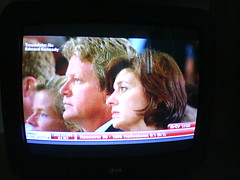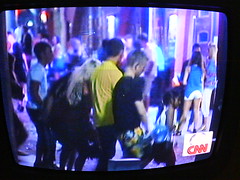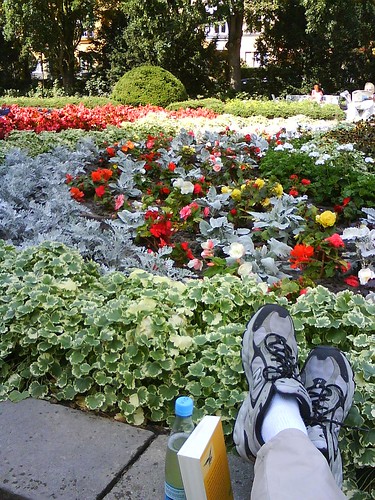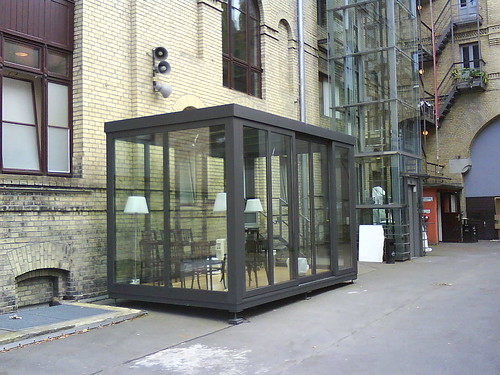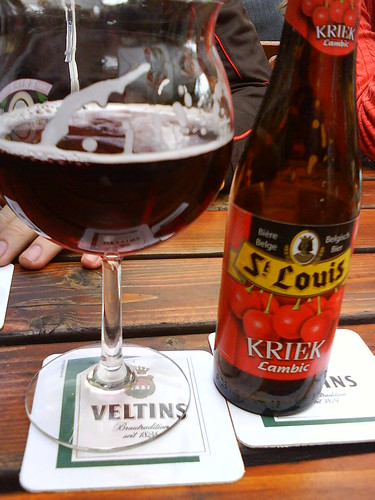Cultural Comparisons
Having previously lived in Vienna for a total of three years, and a year in France way back when, I've been able to adjust to Berlin without culture shock punching me in the gut. But it is an adjustment.
For most matters, my point of reference is Vienna. Tipping? Like Vienna. Buying a monthly transit pass? Like Vienna. Showing your transit pass when the undercover controllers descend on your subway car? Like Vienna. Registering your address with the local authorities? Like Vienna. Fumbling like a madman to pack your groceries, pay, and not annoy either the clerk or the people behind you in line? Like Vienna. Walking miles a day? Like Vienna. (A rough guess based on my pedometer is that I average five miles of walking a day.)
But there are differences, many of them subtle. Viennese German is marked by its politeness, or as some would say its quaintness. Berliners are more informal, a more ragtag bunch, and propriety throws them off. In Vienna I would end a phone call with "Auf Wiederhören" ("until the next time we speak"). Here, each time I do so, the person at the other end of the line is thrown off, and quickly replies "Tschüss," a generic German "bye."
The thing about "Tschüss" is that no self respecting Austrian would ever let such silliness pass his lips. A good, sturdy Austrian hello/goodbye is "Servus," which really means "I am at your service"--there's that Austrian politeness. When you say "Servus," you do so in a nice, deep baritone. A man can say "Servus" and feel manly. "Tschüss," however, is a word you can only say in a soprano voice. Imagine the stewardess Barbies saying "Buh-bye, buh-bye, buh-bye now" as you deplane. Even worse, there's "Tschüssi" (I may be off on the spelling. Just add a long e sound to the end of the word.) This abhorrent form of goodbye is pronounced in a falsetto, as if spoken by mice who've inhaled helium.
So whereas Austrian sounds sturdy and deep, Germans speaking German (Bundesdeutsch!) sound a bit like cartoon animals to me. And I miss being able to say things in a less preposterous way, though I know doing so would mark me as, probably, a south German.
I do spend a lot of time processing what words get used here that aren't the words I'm accustomed to. "Apfelschorle" instead of "Apfel gespritzt." "Trödelmarkt" instead of "Flohmarkt."
Just as I compare linguistic habits, I compare urban landscapes. It's actually not so easy to compare Berlin and Vienna. If I had to pick a city that most resembles Berlin I would probably pick New York. It is a vast city, spread out over a huge area. Despite the remarkably good transit network, it regularly takes an hour to get from point A to point B.
Vienna has a definite center (the first district) and all roads lead there. Berlin has no center whatsoever. I'm not sure if that's a function of its past as a divided city, or simply of its sheer breadth. Neighborhoods are self contained. The government buildings around the Reichstag form one center, Kudam another, Mitte another, Alexanderplatz another, Museum island another. Kreuzberg is its own world, as is Prenzlauerberg, as is... you get the idea.
Spend a day in Vienna, and you won't have gone inside everything, but you will have identified what is important to see. After a month, I still have only a dim idea what should be on my Berlin bucket list. I'm still finding my way around.
Berlin is surely an international city, but my impression is that it is less so than Vienna, and I think the reason for that is that Vienna is so thick with diplomats and people working for international organizations (the UN, OPEC, etc.). Berlin is international in a very different way, attracting twentysomethings in search of Bohemia. (Our bike tour guide was from far northwestern Canada.) For lack of diplomats, I think a lot less English is spoken here as well.
Restaurant culture is similar here: You order, you get what you ordered, and until you ask for the bill, nothing else happens. It's a culture that lends itself to sitting around and talking. But that's where that similarity ends. Viennese, the saying goes, want to be left alone, but need company to do so (which is why the Kaffeehaus is such an important part of Viennese life). I'm not at all so sure Berliners want to be left alone. They strike me as a chatty bunch, and their restaurant culture probably has more in common with a beach bar in Spain than a Kaffeehaus in Vienna.
Speaking of which, boy oh boy do they have beach culture here. There are numerous artificial beaches along the Spree, gigantic sandboxes for beach volleyball, and the like. It's as if it were some freak accident of geography that Berlin, which by rights ought to be somewhere on the Mediterranean coast, just happened to be plopped very much in the center of a landmass.
Austria is more of a wine culture. Germany is more of a beer culture. In either place, beer is cheaper than water.
Vienna has Viennese food, of which they are very proud, as well as imported cuisines to a lesser degree. Berlin has food. It's major food groups are: 1) Beer and pretzels 2) Turkish fast food 3) Vietnamese and Thai food. At a slightly fancy restaurant my lovely wife ordered Tafelspitz, which is, um, Viennese.
When you're living abroad, you can't help but spend your days comparing these things to those things, so you've probably not heard the last of this line of thinking.
P.S. I have thoughts about the Austrians and the Germans and their respective relationships to history, but that's another day's story.
Es lohnt sich / Es lohnt sich nicht #4
This edition of Es lohnt sich / Es lohnt sich nicht is a two-for-one about photography exhibits.
A couple of weeks ago, we went to an exhibit of Helmut Newton photography at the Museum for Photography. I'll assume you know his work (and if you don't, you probably do without realizing it). He did a lot a nude portraits of women, in which the women somehow seem powerful and intimidating. If you are an adult person and your boss isn't standing next to you, you can see selections from the exhibit here: http://www.helmutnewton.com/current_exhibitions/sumo/gallery.html.
We went on a Thursday evening, when the exhibit was free. Verdict? Es lohnt sich. And not just because it was a free exhibit.
One of my favorites:

Yesterday I went to see an exhibit at the Akademie der Künste of photographs from the waning years of East Germany. Hmm. You need to be some weird amalgam of photographer and historian to appreciate many of the works exhibited. Let's first state the obvious, which is that the DDR wasn't such a happy place. I wouldn't say that the exhibit makes it possible to get more than a passing glimpse into the DDR. The aesthetic aspects partially obscure the historical aspects.
Verdict: I'm going to go with Es lohnt sich nicht, because I'm ambivalent. 5 Euros is too much to pay for ambivalence.
A shot of one of the Boschies at the exhibit:
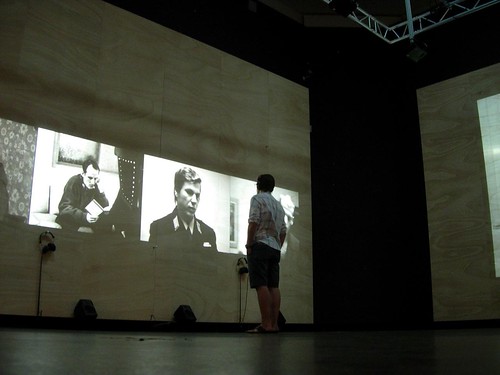
Info about the exhibit in German: http://www.adk.de/de/aktuell/veranstaltungen/index.htm?we_objectID=24726
Berlin Fun Fact: Teufelsberg
Today I was wandering round Grunewald, a large forested park at the western edge of Berlin. One of our destinations was Teufelsberg (Devil's Mountain). I gather there was something of a hill there to begin with, but after WWII, it was the place where 12 million cubic meters of debris from 400,000 bombed buildings was dumped. From afar, it looks like a forested hill. From up close, you can see that the stones are bricks, tiles, and the like.
Es lohnt sich / Es lohnt sich nicht #3: Berliner Ensemble Tour
German theaters and operas generally take the summer off, so the performing arts options are fairly thin at this time of year. But a man can dream, right?
On August 12 (gosh the days slip by quickly) I took a tour of the Berliner Ensemble, joined by a couple of Bosch friends I dragged along. For those not in the know, the Berliner Ensemble is closely associated with Bertolt Brecht. The building is a good deal older than the ensemble. It was built in 1892, and became known as the Theater am Schiffbauerdamm. In 1928, the premiere of Brecht's Dreigroschenoper (Threepenny Opera) took place there. Brecht and his wife Helene Weigel created the Berliner Ensemble in 1948, and moved into the Theater am Schiffbauerdamm in 1954. It is a house with a lot of history.
Here's Brecht and his theater.

Our tour guide was Werner Reimann, a jolly 75 year-old Ensemble member who has left the boards but clearly keeps himself entertained as the theater's sole tour guide. (He explained that he had to, because the students who led the tour were so awful.) Not a bit proud, he gave everyone on the tour a newspaper clipping about him: This year marks his 75th birthday, his 55th anniversary, and his 50th year with the Berliner Ensemble. He has given the tour 650 times since 2000 and I suspect he will keep doing so until he dies.
Though a druggist by training, Helene Weigel added him to the company. She was looking for untrained actors who had presence. (Translation: this guy is a natural ham.) His first part was a small role in The Life of Galileo. Not a shabby beginning at all for a theater career.
It was great fun to hear him talk about and do impressions of Brecht (who had a high, girly voice) and Weigel (who had a low, manly voice). She was clearly the person in charge.
Here Reimann is in front of a wall of plaster casts of actors faces. (These are used by costume designers to try stuff out without having the actors present.) The face in the center is Brecht. Reimann says his is at home, and that they often converse with each other, which is pleasant because he seldom disagrees with anything he says.
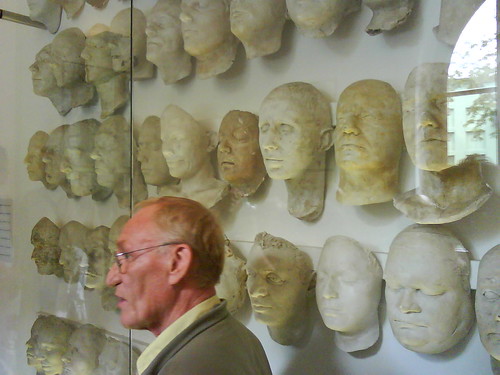
The current director, Klaus Peymann, saw fit to have this glass room built. Before I tell you what it is, see if you can guess.
This, my friends, is a smoker's lounge for the actors. In winter it's cold, and the smokers need someplace warm to get their fix. Somehow, I don't think an American theater director could ever get away with building smoking facilities, but this is old Europe.
Peymann, by the way, was the director of the Burgtheater in Vienna during most of my time there, so I have a strong hunch that I know all the tricks in his bag already. I digress. I would still love to see some plays at the Berliner Ensemble.
It is a charming, lived-in old theater that has survived a lot. Tour guide is tops, provided that you speak German and enjoy theater anecdotes.
Verdict: Es lohnt sich.
I must, I must, I must increase my bust.

If you go walking around Kreuzberg, you might spot this political poster in which local pol Vera Lengsfeld ties herself to Angie Merkel with the slogan "We have more to offer." What on Earth?! For more info: http://www.thelocal.de/politics/20090811-21167.html
Berlin-Hohenschönhausen
Last Friday (14 August) we visited the Berlin-Hohenschönhausen Memorial, a former Soviet and East German prison. It's a very ordinary-looking place where very awful things happened.
To keep this simple, there's an old building and a new building.
The old building was a Nazi-era kitchen. The Soviets then took over the building and turned the basement, designed as a food warehouse, into a prison. Known as the U-Boot, or submarine, prisoners were held 24 to a room with barely any circulating air and no natural light whatsoever. A bucket functioned as the prisoners' shared toilet, and if you were fortunate, they emptied it once a day. Prisoners had to stand all day, had no beds, and sleep was essentially impossible. They wore whatever clothes they came in. If you were arrested in summer in light clothes, that was nevertheless how you spent the cold, unheated winter. Because so many people were crammed together, there was significant condensation.
If that wasn't awful enough for you, maybe you'd enjoy the water torture room where it drip-drip-drips on your head until you can't stand it, at which point your option is to plunge your head into a bucket of water, at which point, in the interest of not drowning, you go back to the drip-drip-drip.
I asked the guide if there was a lot of mental illness amongst the prisoners. She said that every single person who made it out alive suffered permanent mental damage. Sie haben überlebt, aber nicht überstanden. (They lived through it, but they didn't survive it.)
Control of the camp passed to the East German secret police, the Stasi, who used it to hold political prisoners. The East Germans were marginally more enlightened, and built a new building where comparably awful things happened, but which was designed such that European observers would have nothing to pin on them. Thus there was natural light (though no view of the sky), a toilet, a bed, etc. But prisoners were kept in absolute isolation, and the Stasi had sneaky tricks. For example, they could shut off your water or heat as punishment, and plausibly deny any malicious intent. Prisoners, who had nothing but time, attempted to communicate by knocking on the wall in a simple code. But doing so was risky. The Stasi could take a prisoner out of a cell, and from that cell knock on the wall as if they were a prisoner. Any information gleaned this way could be used against you.
You had to stand all day. At night the light came on every five minutes so you were in a constant state of sleep deprivation.
Prisoners were transported to the prison in what looked like a plain delivery vehicle that might have been carrying flowers or bread. Inside, there were 6 cramped transport cells. After picking you up, the truck drove around and around so you had lost all orientation and had no notion where you might be. When you got to the prison you were let out inside an enclosed, brightly lit garage so that you would be instantly blinded as your eyes adjusted. The only place where a prisoner could see the sky was in the so-called tiger cage, and for psychological reasons the sky was obstructed by a chain-link barrier. There was no way to see what buildings were nearby, no way to say where the prison was. The site was highly off-limits, and didn't even appear on East German maps.
Getting your photo taken took an unusually long time. As you sat their you were actually getting a dose of radiation designed to give you cancer eventually. I asked out guide if then the purpose of the camp was to kill the detainees. She hemmed and hawed a bit in answering. Yes, from the Stasi's point of view, it would certainly be best if you died, but they wanted you to die in a way that couldn't be pinned on them.
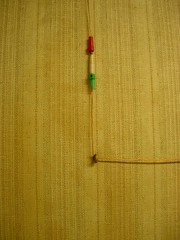 There was a simple red light / green light system (sort of like radio station's "On Air" light) that the Stasi followed so that the prisoners would never see anyone they weren't intended to see.
There was a simple red light / green light system (sort of like radio station's "On Air" light) that the Stasi followed so that the prisoners would never see anyone they weren't intended to see.
None of the guards wore weapons, which meant that there were no weapons to steal, which meant that no one ever escaped. There was a wire strung along the hall. Pulling the wire would break the cicuit and trigger an alarm, resulting in reinforcements showing up quickly.
The West German government regularly "expatriated" prisoners (that is, they bought their freedom). When that happened, the former prisoners had no useful information to provide. They couldn't say where the prison was, they couldn't say who their interrogators were, they couldn't demonstrate that the prison violated European norms.
The Soviets' method of operation was violence. "According to Soviet statistics 886 people died here [the submarine] between July 1945 and October 1946. However, it is estimated that more than 3,000 detainees actually perished in the camp."
The East Germans' method of operation was psychological. Our guide gave us the example of a prisoner she knew who was shocked upon going into the interrogation room to find that his interrogator was his father. It wasn't really--it was someone chosen for this particular interrogation based on his resemblance to the prisoner's father, and made to look as much like him as possible. Later, when the Stasi files were opened, the former prisoner learned that the Stasi psychologists knew that he was very close to his father, and that this would be the way to push his buttons.
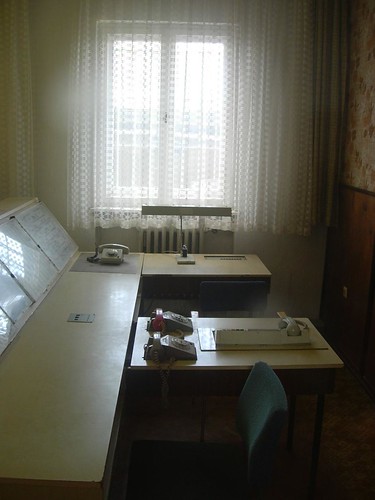 Hohenschönhausen only closed 20 years ago. It's a sobering place to visit as an American. I doubt that anything that happened there is uniquely unlike the so-called harsh interrogation techniques Dick Cheney and his little friend W. brought upon us. The explicitly violent Soviet prison brings to mind Abu Ghraib. The by-the-book legality yet sheer awfulness of the Stasi prison probably gives you a good idea of what the CIA does these days.
Hohenschönhausen only closed 20 years ago. It's a sobering place to visit as an American. I doubt that anything that happened there is uniquely unlike the so-called harsh interrogation techniques Dick Cheney and his little friend W. brought upon us. The explicitly violent Soviet prison brings to mind Abu Ghraib. The by-the-book legality yet sheer awfulness of the Stasi prison probably gives you a good idea of what the CIA does these days.
The photo on the right shows a room where the Stasi kept an eye on operations. It looks ordinary, and I am reminded of the concept of the "banality of evil."
If you were released, you couldn't go back to your prior profession, and had to settle for lesser work. If you were an interrogator, you were well paid by East German standards. It's essentially impossible to charge them with crimes, since the prisoners never knew their identities, and since norms were maintained. It's a safe assumption that they are now living prosperous lives--during reunification, the exchange rate for East German Marks to West German Marks was 1 to 1.
To keep this simple, there's an old building and a new building.
The old building was a Nazi-era kitchen. The Soviets then took over the building and turned the basement, designed as a food warehouse, into a prison. Known as the U-Boot, or submarine, prisoners were held 24 to a room with barely any circulating air and no natural light whatsoever. A bucket functioned as the prisoners' shared toilet, and if you were fortunate, they emptied it once a day. Prisoners had to stand all day, had no beds, and sleep was essentially impossible. They wore whatever clothes they came in. If you were arrested in summer in light clothes, that was nevertheless how you spent the cold, unheated winter. Because so many people were crammed together, there was significant condensation.
If that wasn't awful enough for you, maybe you'd enjoy the water torture room where it drip-drip-drips on your head until you can't stand it, at which point your option is to plunge your head into a bucket of water, at which point, in the interest of not drowning, you go back to the drip-drip-drip.
I asked the guide if there was a lot of mental illness amongst the prisoners. She said that every single person who made it out alive suffered permanent mental damage. Sie haben überlebt, aber nicht überstanden. (They lived through it, but they didn't survive it.)
Control of the camp passed to the East German secret police, the Stasi, who used it to hold political prisoners. The East Germans were marginally more enlightened, and built a new building where comparably awful things happened, but which was designed such that European observers would have nothing to pin on them. Thus there was natural light (though no view of the sky), a toilet, a bed, etc. But prisoners were kept in absolute isolation, and the Stasi had sneaky tricks. For example, they could shut off your water or heat as punishment, and plausibly deny any malicious intent. Prisoners, who had nothing but time, attempted to communicate by knocking on the wall in a simple code. But doing so was risky. The Stasi could take a prisoner out of a cell, and from that cell knock on the wall as if they were a prisoner. Any information gleaned this way could be used against you.
You had to stand all day. At night the light came on every five minutes so you were in a constant state of sleep deprivation.
Prisoners were transported to the prison in what looked like a plain delivery vehicle that might have been carrying flowers or bread. Inside, there were 6 cramped transport cells. After picking you up, the truck drove around and around so you had lost all orientation and had no notion where you might be. When you got to the prison you were let out inside an enclosed, brightly lit garage so that you would be instantly blinded as your eyes adjusted. The only place where a prisoner could see the sky was in the so-called tiger cage, and for psychological reasons the sky was obstructed by a chain-link barrier. There was no way to see what buildings were nearby, no way to say where the prison was. The site was highly off-limits, and didn't even appear on East German maps.
Getting your photo taken took an unusually long time. As you sat their you were actually getting a dose of radiation designed to give you cancer eventually. I asked out guide if then the purpose of the camp was to kill the detainees. She hemmed and hawed a bit in answering. Yes, from the Stasi's point of view, it would certainly be best if you died, but they wanted you to die in a way that couldn't be pinned on them.
 There was a simple red light / green light system (sort of like radio station's "On Air" light) that the Stasi followed so that the prisoners would never see anyone they weren't intended to see.
There was a simple red light / green light system (sort of like radio station's "On Air" light) that the Stasi followed so that the prisoners would never see anyone they weren't intended to see. None of the guards wore weapons, which meant that there were no weapons to steal, which meant that no one ever escaped. There was a wire strung along the hall. Pulling the wire would break the cicuit and trigger an alarm, resulting in reinforcements showing up quickly.
The West German government regularly "expatriated" prisoners (that is, they bought their freedom). When that happened, the former prisoners had no useful information to provide. They couldn't say where the prison was, they couldn't say who their interrogators were, they couldn't demonstrate that the prison violated European norms.
The Soviets' method of operation was violence. "According to Soviet statistics 886 people died here [the submarine] between July 1945 and October 1946. However, it is estimated that more than 3,000 detainees actually perished in the camp."
The East Germans' method of operation was psychological. Our guide gave us the example of a prisoner she knew who was shocked upon going into the interrogation room to find that his interrogator was his father. It wasn't really--it was someone chosen for this particular interrogation based on his resemblance to the prisoner's father, and made to look as much like him as possible. Later, when the Stasi files were opened, the former prisoner learned that the Stasi psychologists knew that he was very close to his father, and that this would be the way to push his buttons.
 Hohenschönhausen only closed 20 years ago. It's a sobering place to visit as an American. I doubt that anything that happened there is uniquely unlike the so-called harsh interrogation techniques Dick Cheney and his little friend W. brought upon us. The explicitly violent Soviet prison brings to mind Abu Ghraib. The by-the-book legality yet sheer awfulness of the Stasi prison probably gives you a good idea of what the CIA does these days.
Hohenschönhausen only closed 20 years ago. It's a sobering place to visit as an American. I doubt that anything that happened there is uniquely unlike the so-called harsh interrogation techniques Dick Cheney and his little friend W. brought upon us. The explicitly violent Soviet prison brings to mind Abu Ghraib. The by-the-book legality yet sheer awfulness of the Stasi prison probably gives you a good idea of what the CIA does these days.The photo on the right shows a room where the Stasi kept an eye on operations. It looks ordinary, and I am reminded of the concept of the "banality of evil."
If you were released, you couldn't go back to your prior profession, and had to settle for lesser work. If you were an interrogator, you were well paid by East German standards. It's essentially impossible to charge them with crimes, since the prisoners never knew their identities, and since norms were maintained. It's a safe assumption that they are now living prosperous lives--during reunification, the exchange rate for East German Marks to West German Marks was 1 to 1.
Es lohnt sich / Es lohnt sich nicht #1
I'm attracted to the idea of a regular feature called "Es lohnt sich / Es lohnt sich nicht" (It's worth it / It's not worth it).
For instance, yesterday I went to a corn maze with my wife and one of her friends. It sounded cool. It looked cool in the newspaper.

But the place was nearly deserted. The cow is only visible from the sky. There was nothing to eat or drink. Pshaw. Verdict: Es lohnt sich nicht.
For instance, yesterday I went to a corn maze with my wife and one of her friends. It sounded cool. It looked cool in the newspaper.

But the place was nearly deserted. The cow is only visible from the sky. There was nothing to eat or drink. Pshaw. Verdict: Es lohnt sich nicht.
Preliminaries
A few thoughts as I get this blog up and running:
1. I have a strong hunch that this blog isn't going to be particularly chronological. For example, if it takes me a while to download photos from my camera or phone to my computer, and then to upload them, other events and stories may intervene.
2. I said I wasn't going to blog. We'll see how this goes.
3. If you encounter formatting problems, please comment to let me know.
1. I have a strong hunch that this blog isn't going to be particularly chronological. For example, if it takes me a while to download photos from my camera or phone to my computer, and then to upload them, other events and stories may intervene.
2. I said I wasn't going to blog. We'll see how this goes.
3. If you encounter formatting problems, please comment to let me know.

